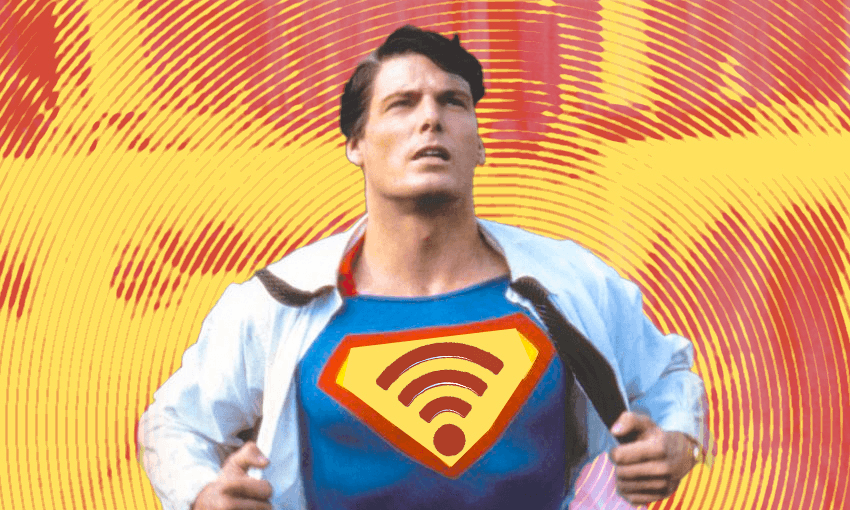When it works, wifi feels like magic; when it doesn’t, it feels like the world has stalled. The Spinoff spoke to Vodafone wifi expert Mark Beaton about how its rapid evolution is changing the way we live and creating better connections.
In the early years of the internet, it was all about plugging in. Surfing the web meant heavy cables coming out the back of your household’s single massive desktop. If you wanted to surf the information superhighway, you had to wait for your Mum to get off the phone.
Then, thanks to an amazing thing called wifi (or wireless fidelity), we unplugged, and the technological evolution was catapulted into a new epoch. In 2016, humanity entered the Zettabyte Era: global internet traffic exceeded one zettabyte (1,000,000,000,000,000,000,000 bytes). This was largely down to video streaming, which used to be confined to YouTube and desktop computers; now it’s on Netflix and Neon, and on almost every phone and tablet.
Wifi has become an essential part of our lives. We store everything from our family photos to unfinished first novels in the cloud. The Internet of Things (IoT) connects us to our TV, security cameras, heat pump and fridge. A recent Vodafone Consumer Insights survey found New Zealanders ranked wifi as the third most important piece of their everyday life – just behind family and taking a shower, and ahead of a car, washing machine or TV.
The average New Zealand household currently has nine wifi-capable devices in it and growing fast with data use increasing by more than 40% each year. Mark Beaton, device engineer at Vodafone and all-around wifi expert, says he regularly sees customers with 15 or more devices in their homes. “Some customers are wifi only – they have no cabled devices in their houses,” he said. “This has all changed just in recent years. It’s accelerating at an ever-increasing rate.”
Last year, wifi-6 came on the market. Yes, just like cell phone networks – your 4Gs and 5Gs – wifi has generations. “The first generation wifi – that’s going back about 20 years now,” said Beaton.
The evolution of wifi
Wifi as we know it began two decades ago. Proto-Wifi had been around for a long time before that.
“If you think back to even during the wars and early radio communication – proto wifi really started off as a way of wireless communication,” he said. “Wireless connections have been around for a long, long time. It’s all radio wave technology, just like you’d see in your car or on a walkie talkie, or even your cell phone.”
The router, or “modem” in New Zealand, holds a radio antenna that sends and receives data to and from your device, like a silent walkie-talkie.
It was about 10 years ago that wifi really started to take off, as more wifi-enabled devices were introduced to the market. The family computer died out, replaced with multiple laptops, tablets and cell phones. “Certainly in the last five years you’ve got a lot of smart devices as well – your tv, your lightbulb,” said Beaton. “The use of wifi has really exploded, and we have to try and keep up with it.”
The radio antennae inside our modems have more data to send and receive than ever before, so wifi-6 has evolved to match the way we use wifi now – constantly, on the move and with ever-increasing demands on data capacity.
“The evolution of wifi allows users to connect faster, and have more devices online at the same time, as well as having a greater level of coverage around the home making our lives truly wireless,” said Beaton.
Vodafone’s latest initiative, SuperWifi, is aiming to make users less complacent about terrible wifi – because the good stuff exists. We just aren’t tapping into it.
What’s the problem?
Most of us have a wifi dark spot in our house – a place that, though the sun may reach it, the internet never will. You’ve tried opening all the doors between this spot and your modem. You’ve stood up high on a chair to get closer to the heavens, which our reptilian brains assume generates wifi in the same way it does cell phone signals. A colleague even sits on the toilet with his phone on his head in an attempt to create a human antenna to get better reception in his bathroom.
“Wifi isn’t something you can use anywhere,” said Beaton. “There is a range on it. When you have a single modem, which has been the norm for a long time, that limits how far it can go.” If you put a modem in a metal box, it wouldn’t work. If you put it in the garage and tried to use wifi in your far-end bedroom, it might not work.
You can buy a modem with bells and whistles and fancy antennae, but at the end of the day, its wifi output is limited. Take that limited output, add nine (and counting) connected devices and a dozen other electronics emitting radio waves that get in the way, throw in poor modem placing, and you’ve got wifi that is just not giving you the best experience.
“Everything in the house interferes with wifi signal,” said Beaton. “Plasterboard walls not so much, but if your modem is next to a large electronic device like a fridge, it can block the signal, or reflect signal, or just jumble things around a lot.”
“Even in a small house, the signal may not get far because the room next door is the bathroom, which is fully tiled.”
No, opening a door won’t help. Wifi doesn’t walk down hallways like you or I; it bounces around from floor to roof to device and back again. And doors are mostly hollow, anyway. So what does help?
Solving your wifi woes: the SuperWifi solution
The days of the single modem are numbered.
“Mesh wifi is the hot thing at the moment,” said Beaton. “You take the wifi transmitter in your modem, and you split it up.” Two modems talking to each other, spread out around the house; that’ll get you more coverage.
Beaton likens mesh wifi to cell phone networks. “We don’t have one cell phone tower in the middle of the city, we have lots of towers dotted around. This is the same concept.”
The Deco X20 units currently offered by Vodafone are one option for a mesh network. “As you move around the house, the Deco units actually switch you between one and the other,” said Beaton. “They always put you on the strongest signal.”
The technology in these units allows you to prioritise your dozen devices instead of leaving it to the wifi gods. Instead of having a nagging child demand you to“get off, get off” the phone so they can join a chatroom; these days you can tell the Deco to prioritise your Zoom session over the PlayStation use. They’ll both work, but if a rogue radiowave jumbles your wifi the Zoom call will come out the winner.
The Deco X20 nodes also give parents more control over the household wifi, with far less effort. If you’re sick of your kids spending hours on YouTube in the middle of the night, lost in the vortex that is Fortnite for days or, even worse, seeing things online you don’t want them to see, the worry is over. The Deco app lets you limit the amount of time individual devices spend online, as well as block apps and websites you don’t want them using. Forget about giving out pocket money, these days “wifi hours” are the new currency for wrangling the kids.
And the more nodes you have, the further your wifi can go. It’s peak wireless technology. It’s SuperWifi. And for many of you, it will be free to get. Because living with bad wifi isn’t something you need to put up with.

